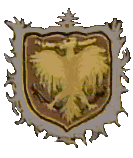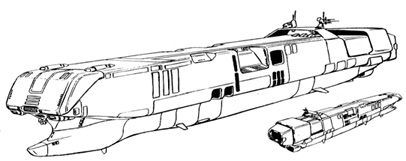

Designation:Daedalus-class Submersible Landing Ship (SLV) |

|

|
|||

|
|||||
| SLV-111 | Daedalus | IS | Commissioned 2007 | Operational loss at Macross Island, 2009. |
| SLV-112 | Perseus | IS | Commissioned 2008 | In reserve 2024, scrapped 2047. |
| SLV-113 | Ajax | RDY | Commissioned 2008 | Sunk in the Pacific, 2019. |
| SCC-001 | Orion | KW | Commissioned 2008 | Sunk in the South Atlantic during the 2nd Robotech War, 2029. |
| SLV-115 | Iphigenia | RDY | Commissioned 2009 | In reserve 2024, scrapped 2047. |
| SLV-116 | Ulysses | KW | Commissioned 2009 | Sunk in the Caribbean Sea, 2017. |
| SCC-002 | Achilles | NSMW | Commissioned 2010 | Missing and presumed destroyed in the Pacific Ocean, 2033. |
| SCC-003 | Jason | NSMW | Commissioned 2010 | Sunk near Diego Garcia, 2031. |
| SLV-119 | Agamemnon | IS | Commissioned 2011 | Constructional total loss, Atlantic Ocean 2015, scrapped 2016-2017. |
| SLV-120 | Argonaut | IS | --- | Scrapped on the building way, 2013. |
| SLV-121 | Apollo | KW | --- | Destroyed on the building way in the Zentraedi Holocaust |
| SLV-122 | Artemis | KW | --- | Destroyed on the building way in the Zentraedi Holocaust |
These ships were built by the Ingalls Shipbuilding (IS, Pascagoula, USA), Rotterdam Dockyard Company (RDY, Rotterdam, Netherlands), Kobe Works (KW, Kobe, Japan) and Nagasaki Shipyard & Machinery Works (NSMW, Nagasaki, Japan) shipyards.
See Naval air group compositions for a detailed summation.
The Daedalus class was shaped much like the Wasp- and Tarawa-class landing ships as built for the pre-unification US Navy. The vessels had a rectangular upper deck and hull on top of a standard ship hull. This enabled the Daedalus-class to have a more efficient pressure hull than the Prometheus-class, which was based on the US supercarriers. As a result, the Daedalus-class had superior underwater performance in comparison with the Prometheus-class.
The ship was topped by a full length flat deck, with only two very small conning towers on top of from it. At the bow this deck angles into a 60 degree descent towards the waterline. This sloping deck can be opened upwards, enabling the mecha landing ramp to be extended to the beach and mecha to be marched from the insides of the ship to their objectives. The hull also features two retractable side ports amidships. These ports were useless in a beach landing operation, but served as the main access to the mecha hangars while in port.
The internals of the vessel were much like any other naval vessel, with one exception. The upper 36 meters of the forward two-thirds of the vessel formed a giant mecha hangar. This hangar was divided by bulkheads and decks into a two level mecha garage, but in terms of its pressure hull, was a single compartment. This gigantic hangar housed the destroids of the vessel. The bay opened directly on the forward mecha landing ramp and the side ports. A removable ramp can connected the upper part of the bay with the lower part, enabling mecha to navigate the hangar under their own power. The upper deck was suited for helicopter and VTOL operations, but there were no elevators and any aerial craft had to be pulled out of the hangar to the beach first, then prepped and flown off.
Below these were man-sized decks housing crew, armories, magazines, workshops and all the rest needed to keep over 2,850 men in fighting shape for a deployment length of up to 12 months. They also included the engineering spaces. Fission reactors were used rather than Reflex furnaces, because at the time of design, these latter were only limited available. The entire side protection system against torpedo hits doubled as a ballast tank, and additionally, what appeared to be the lowest deck level was in fact also a ballast tank. All this tankage was needed to overcome the enormous flotation ability inherent in so large a vessel.
Due to extensive automation these giant vessels needed less crew than their smaller predecessors. With a crew of 1660, these vessels had almost half the complement of their ancestors.
The armament installed on these vessels was less capable than that onboard the Prometheus carriers, and ships' losses were higher as a result.
As submarines these ships were hampered by their assault design, and their speed was a fraction of what nuclear submarines could make. In addition, there was no way these ships could run silently, and therefore no silencing measures were seriously considered. Hence, in a conflict with Earth navies the class would be one large target for the opponents' submarines, or would need an entire flotilla of attack submarines as escort. It was thought however, that space borne invaders would not have the necessary sonar expertise to track these noisy vessels. This assumption proved to be correct.
In 2024, three of the five surviving members of this class were converted into command ships, a conversion which included a drastic lowering of the mecha complement (now only required for self-defense), installation of additional communications equipment, and expansion of the storage spaces, C3I rooms etcetera into the former mecha hangars. The other two vessels were laid up and served as parts suppliers for the operational craft.
The Daedalus-class was developed in parallel with the Prometheus-class of submersible aircraft carriers, but unlike that class, the Daedalus was intended to land destroid forces directly over a beach. The origins of this concept date back to the question put to military staffs on how to ensure that sufficient armed forces survived a possible alien attack to carry out a counter offensive against the aliens. The answer was that the best way for armed forces to survive would be to be invisible from orbit: hence, the submersible nature of the Daedalus.
The Daedalus-class was an object of antipathy for carrier officers, who found the concept of a large, vulnerable over-the-beach landing ship to be several decades out of date with modern amphibious thinking, which now emphasized standing off the beach and mobile assaults on lesser defended areas. Also there were no organic resupply helicopters assigned to the destroid regiment, requiring them to return to the beached ship for maintenance and resupply. The displaced Marine forces and their air transport now took up spaces on board the Prometheus-class submersible carriers, another sore point. In addition, the Daedalus class would be of very limited utility in a fight with the aliens but the class did pull budgets and yards from the construction of more submersible Prometheus class carriers. Conversely, Marine and Army commanders defended the existance of the class, pointing out that Destroids, the most effective ground based counters against Zentraedi battlepods at that time envisaged, could not be easily transported to shore using smaller landing craft and helicopters. History proved that both classes were of very limited utility against space invaders, but that the effort put into the Daedalus class might indeed have been better placed in more Prometheus hulls. As a result of the various in-service fights, the number of Daedalus hulls was limited and no more were ordered, with the yards ordered to switch to Prometheus vessels after 2013.
One vessel, the Daedalus, was present at Macross Island and attending the launch festivities on that day. The Daedalus was included in the SDF-1 spacefold and gave excellent service after that, but no longer as a seagoing vessel. Her engines were removed, her hull reinforced, and additional access ramps were built to serve the upper deck, enabling her to have destroids and battloids walk on the upper deck, to provide fire support if needed. The upper deck also served as a civilian area when the SDF-1 was on Earth and not on high standby.
The eight other ships survived the Holocaust, and were used by the RDF as troop carriers. Three uncompleted sister ships were destroyed in the yards or scrapped before launching after the war. Their lesser armament and mecha operations led to less charmed lives than the Prometheus class, though. The Agamemnon was attacked by Fighter pods off the Brazilian coast just when a Seraum Awhaug (MPA-5 Moloch) missile salvo occupied the defenses. The combat air patrol managed to destroy enough malcontent Fighter Pods to keep the ship from sinking, but the damage was so heavy that the hull was scrapped at Oslo two years later. Ajax and Ulysses succumbed to a Quel Quallie squadron off the Peruvian coast and a Regult/Glaug force on the Jamaican beach during attempted landing operations. After these debacles, no more Daedalus-class ships were used as amphibious assault ships without a Prometheus escort.
The other vessels, now numbering only five, survived the uprisings. After the last large REF deployments the class was to be retired from service and scrapped. However, a new tasking was found for some of these large and relatively new hulls. Three of the class, Orion, Achilles and Jason, were converted into command ships (SCC) for the Southern Cross navy. Their mecha complements were reduced to one batallion, and the freed hangar space was converted into offices, C3I facilities, high quality berthing and communications installations. One command ship each was assigned to the Pacific Ocean theatre, the Atlantic Ocean theatre and the Indian Ocean theatre. The two remaining ships, Iphigenia and Perseus, were relegated to reserve status in Newport News, and provided many of the parts required to keep the other three ships operational.
During the Second Robotech War the Orion was caught on the surface by Tirolian forces and destroyed by a Bioroid and Roil assault corvette strike force north of the Falkland Islands. The Jason was sunk near Diego Garcia during the Invid Invasion, and the Achilles disappeared in the Pacific at that time, together with the Prometheus-class carrier Phoebe. Both ships have been listed as missing, presumed destroyed, and it is hoped their fate will be disclosed when the surviving Invid archives are opened to human researchers.
Return to RDF Naval index.
Go to Robotech Reference Guide Home Page.
Robotech (R) is the property of Harmony Gold. This document is in no way intended to infringe upon their rights.
Content by Pieter Thomassen, with Peter Walker and Rob Morgenstern